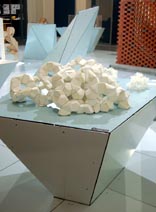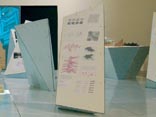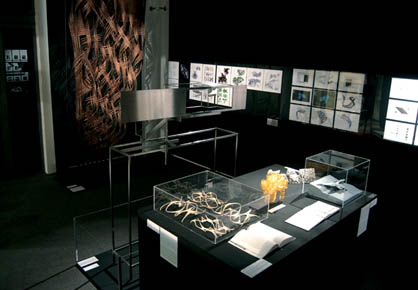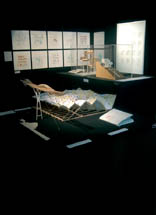|
|
|
Architecture
beyond forms. The computational turn
Philippe
Morel
|
|
|
|
|
On
February 22, 2007 the exhibition Architecture Beyond Forms
- the Computational Turn opened in Marseille, at the Maison de l'Architecture
et de la Ville. The event, organized with the support of FRAC Centre
and Centre Pompidou, aims at presenting an updated view on computation
and digital research in architecture. We are pleased to anticipate
to our readers the introductory texts released by the curator,
Philippe Morel, and the Director of the FRAC Centre, Marie-Ange
Brayer.
|
|
|
|
|
A
veritable epistemic revolution occurred with the advent of digital
technology. The design of a project was no longer concerned with
representation, but rather with calculation and computation. This
would profoundly affect architectural production methods. This upheaval
within the very language of architecture, which would lead to another
level of project temporality, had already been anticipated by the
design practices that emerged in the 1960s through radical architecture
in Europe. Architecture was no longer a constructed object but an
environment being perpetually reconfigured, a thing of the moment.
During the same period in the United States, Peter Eisenman was demanding
autonomy regarding the design of projects as well as a morphogenic
approach to architecture.
|
|
[12mar2007]
|
| |
|
The
FRAC Centre collection, which has been taking inspiration from architectural
experimentation for about fifteen years, bringing together the utopian,
radical projects of the 1960s, is presented in this exhibition through
projects that are emblematic of deconstruction: Coop Himmelb(l)au's
Open House from the beginning of the 1980s, which liberates architecture
from all programming constraints with its eyes-closed design; Zada
Hadid's pictoral compositions of floating spatiality inspired by
constructivism; Bernard Tschumi and the Parc de la Villette, which
is marked by a process of dissociation and fragmentation of form.
All of these projects detach architectural language from its foundations
in order to open up a new cognitive dimension.
The
ArchiLab events, created with Frédéric Migayrou in
1999, helped to bring fame to a generation of architects in France
interested in research on an international scale. A number of these
are featured in the FRAC Centre's collection and in this exhibition:
dECOi architects, Evan Douglis Studio, EZCT Architecture & Design
Research ; KOL/MAC LLC, Objectile, Servo, Xefirotarch and so on.
Constructional architecture, the referent in these various projects,
is inseparable from the genetic exploration of the process. These
self-organisational systems are defined as living, phylogenetic systems,
outside of all "models" and all representational conditions,
opening architecture up to ideas of transformability and adaptability.
Thus, architecture becomes a dynamic environment.
Marie-Ange Brayer
|
|
|
| |
|
The
exhibition Architecture beyond forms - the computational turn is
a modest follow up to several recent events (including Latent
Utopia,
Vienna, 2002; Non-Standard Architecture, Paris, 2003; Intricacy,
Philadelphia, 2003; and The Digital Body, Tours, 2005) that aims
to achieve a better understanding of "architecture in the age
of the computer". Like all exhibitions, its final form is the
result of a number of factors, consisting of both restrictions and
possibilities.
|
|
|

Aranda/Lasch,
Grotto and Crystal Basket. Photo: Jonathan Boussaert/FRAC Centre.
Set design: © Elias Guenoun, Nicolas Simon, Max Turnheim.

Biothing, drawings
for the projects Bifid, Swells and Invisible. Photo:
Jonathan Boussaert/FRAC Centre.
Set design: © Elias Guenoun, Nicolas Simon, Max Turnheim.
|
|

From left to right:
Aranda/Lasch, Grotto et Crystal Basket; DORA, Mesh Models;
Xefirotarch,
Busan Multipurpose Concert Hall, Collection du FRAC Centre.
In the back: EZCT Architecture & Design Research, Chair Model
Test1-860, Collection
du FRAC Centre; Objectile, Panneau et objet sans titre, Collection
du FRAC Centre; Gramazio&Kohler, The Informed Wall, Axel
Kilian, Chair
Project. Photo: Jonathan Boussaert/FRAC Centre. Set design: © Elias
Guenoun, Nicolas Simon, Max Turnheim.
The
exhibition, although defined by a specific sub-title, is not a thematic
one. It is, rather, the result of a long-standing interest of mine
in a subject which, on the contrary, tends towards the universal:
computation. Nevertheless, because this subject is not just mathematical
but also defines a culture, there has always been an underlying question
involved: how can we consider computation without falling into the
trap of an all-embracing analysis at a time when, from the point
of view of computation and in light of the widespread use of computers
in all areas of life, this same computation leads to the most global
and radical transformations. Do we not now talk about computational
biology, computational linguistics, computational geometry, computational
chemistry, computational mechanics and computational economy? Have
we not begun to see, here and there, the emergence of an entirely
new situation in all areas of production, the same production that
was once analysed in depth by Sigfried Giedion?
|
|

Gramazio&Kohler, The
Informed Wall; Axel Kilian, Chair Project. On the right:
Material Systems Organization, Voronoi Morphologies. Photo:
Jonathan Boussaert/FRAC Centre. Set design: © Elias Guenoun,
Nicolas Simon, Max Turnheim.
|

FOA, B.B.C. White
City Music Center, Collection du Centre Pompidou. Drawings on the
wall, left: IJP Corporation, A Study of Curvature as Fragmented Flatness;
Coop Himmelb(l)au and Claude Parent, Open House, Collection
du FRAC Centre; Cadavre exquis, dépôt de Claude
Parent; Zaha Hadid, The Hague Villas, Spiral House, Collection
du FRAC Centre. In the back: dECOi, Vaisseau de Verre, Collection
du FRAC Centre; Bernard Tschumi, La Case Vide, Parc de la Villette,
Collection du FRAC Centre. Photo: Jonathan Boussaert/FRAC Centre.
Set design: © Elias Guenoun, Nicolas Simon, Max Turnheim.
|
|

Servo, In
the Lattice, Collection du FRAC Centre; OCEAN NORTH, Moroho-Ecologies,
book, ed. Michael Hensel, Achim, Menges; YME, Hybrid Spacies,
book and model STL, Kol/Mac LLC, meta_HOM Estouteville 2.0,
Collection du FRAC Centre; Giorgios Artopoulos, The House of Affects.
In the middle: Evan Douglis Studio, Helio-Scopes, Collection
du FRAC Centre. In the back: dzO, Ghost
Track, Collection du FRAC Centre. On the wall: TheVeryMany, series
of studies Rhinoscript, Giorgios Artopoulos, YMA. Photo: Johnatan Boussaert/FRAC
Centre.
Set design: © Elias Guenoun, Nicolas Simon, Max Turnheim.
But
whilst, in 1948, the Swiss historian gave a lucid and even glacial
analysis of the effects of mechanisation on architecture and daily
life, with Mechanization Takes Command, how can we now analyse computation
defined by Jacques Stern, director of the computer science department
at the Ecole Normale Supérieure, as the "mechanisation
of abstraction"? This exhibition does not offer a response to
a question whose importance we still underestimate, but presents
visitors with a collection of objects, drawings and prototypes dating
back to 1963, the year in which Peter Eisenman presented a doctoral
thesis anticipating a number of current issues. This collection,
which will also be analysed in the "Computational Architecture" catalogue,
published by MAV PACA and Editions HYX -with contributions from several
architects, researchers and academics including Benoît Durandin,
Sean Keller, Philippe Morel, Francis Pisani, Caterina Tiazzoldi and
Franck Varenne- will, I hope, allow everyone a fresh reading of these
structures and this research, these conceptual and physical constructions.
Philippe Morel |
|

IJP Corporation,
Henderson Crossing Bridge, A Study of Curvature as Fragmented Flatness,
The Book of Surfaces. In the back, on the wall, right: Peter Eisenman,
Guardiola House, Collection du FRAC Centre. On the wall, left:
Bernard Tschumi, La Case Vide, Parc de la Villette, Collection
du FRAC Centre. Photo: Jonathan Boussaert/FRAC Centre.
Set design: © Elias Guenoun, Nicolas Simon, Max Turnheim.
|
|
|
|
> FRAC
CENTRE
> EZCT |
|
|